We remain hopeful as SQF Complex Fire moves through Alder Creek
“And once the storm is over, you won’t remember how you made it through, how you managed to survive. You won’t even be sure, in fact, whether the storm is really over. But one thing is certain, when you come out of the storm you won’t be the same person who walked in. That’s what this storm’s all about” —Haruki Murakami
We are all so tired. Each day seems to bring a new unprecedented challenge to knock us down and dampen our resolve to get back up and keep moving. We don’t need to hear the list of crisis after crisis that we are enduring because it is carved into our lungs, painted on the boarded up windows of our towns, echoing in the shouts from our streets, and burned into the hills of our rural landscapes.
Today we are being tested again. And again, we are putting our hope in the resilience of the redwood forest to help us through the storm and renew our faith in our own resilience. In the past 48 hours, fires have burned through thousands of acres of ancient giant sequoia forest.
For weeks we have watched while fires swept through California’s coastal mountains. In addition to lives tragically lost and communities burned to the ground, the fires impacted over 90,000 acres of coast redwood forest—including the iconic Big Basin Redwoods State Park. Just as the intensity of those fires began to lessen, the world’s attention shifted to the horrific loss and inescapable smoke from the fires in Oregon and Washington.

Fires in the Giant Sequoia Forest
Meanwhile, Save the Redwoods League has been carefully tracking other fires throughout California, including the SQF Complex Fire (previously known as the Castle Fire) on the western slopes of the Sierra Nevada. Last week, the flames were low-intensity and fire behavior was actually beneficial to the forest. Over the weekend, however, a combination of high wind and low humidity fueled a rapid growth of fire to the west, pushing over the ridge and down into the Alder Creek valley, burning through the League’s Alder Creek property and the adjacent community of Sequoia Crest.
The sudden expansion and redirection of the fire included several other giant sequoia groves as well. All told, the fire has burned through seven different giant sequoia groves, including roughly 15% of the total sequoia acreage in existence.
To be clear, our primary concern is human safety. Since we purchased the Alder Creek property nine months ago, we’ve come to know our neighbors in the Sequoia Crest community. We are relieved and heartened to share that all the residents of the community had safely evacuated before the fire came through. Our hearts go out to them as we prepare for the weeks ahead and learn together of the impacts to the place that we all love so dearly. We continue to be awed by the bravery and compassion shown by the fire crews here and throughout the West who have put themselves at risk to keep people safe throughout the crisis.
I want to stress that we do not yet know of the impact of these fires on either the ancient giant sequoia trees or the many residences that have been built among them. The fires continue to advance across the region, threatening lives, infrastructure, and irreplaceable ecological treasures. The crews are challenged for resources and rightfully focused on safety and rescue. While it may be months before we can fully assess the impact of the fires, there are a few things we do know that might help prepare us for what we may discover when we can access the grove and assess the impact.
Like their coast redwood relatives, giant sequoia are naturally fire resilient, but there are notable differences between the two species. Coast redwoods can resprout from their trunks and roots if their trunks and limbs are heavily damaged by fire, but giant sequoia cannot. We have been studying this at Black Mountain Grove, where severe fire fueled by generations of misguided fire suppression resulted in unprecedented mortality among the monarch giant sequoia.
But every fire behaves differently, and the forest of Alder Creek has a lot going for it. The fuel load is lighter because of judicious forest thinning on the property in the past. And these trees have weathered many fires, surviving for thousands of years.
The Future of Our Forests
As we await our assessment of the impacts, and hope against hope for the best possible outcome, I’m thinking about how we will be changed by this storm; how we will learn the lessons that nature is trying to teach us. Fire in California’s forests is an inescapable reality, and yet we have actively undermined the forests’ natural fire resilience that has evolved over millions of years. In just over a century of fire exclusion, we allowed the unnatural buildup of combustible fuels. That, combined with climate change and generations of commercial clear cutting, has created a catastrophic situation for our forests. We have no choice but to commit to a new era of forest conservation, stewardship, and restoration, with reverence to both science and the traditional ecological knowledge and stewardship of California tribes, including substantial use of fire to manage vegetation.
When we acquired Alder Creek last year, it was the largest unprotected giant sequoia property in the world and the most consequential sequoia conservation project in over 70 years. The grove is breathtakingly beautiful with alpine meadows of wildflowers and hundreds of ancient giant sequoia, including many more than 2,000 years old. This globally unique landscape has burned before, many times, in the long lives of these mighty trees. And it has come back again and again. So now we put our hopes and deepest faith in the power of nature that has allowed the giant sequoia to withstand so much over the millennia, to endure the fires once again, so that we can make the changes we as a society need to make; so that we can come out of this storm ready to make better choices that invest in our future and restore the resilience of California’s forests.
We’ll be sure to keep you updated on the fires’ progression and assessments of the impacts to Alder Creek and other redwood forests. And we will martial our resources to prepare for the work ahead. So please stay safe and stay connected so that together, we can emerge from this storm ready to continue the hard work of protecting, restoring, and connecting people with the redwoods.

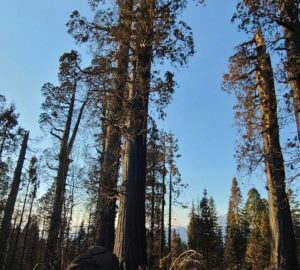
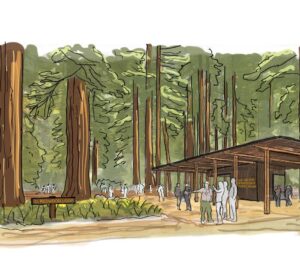

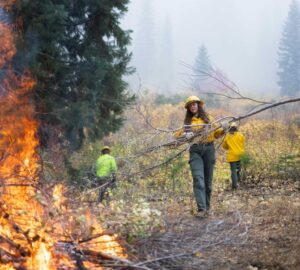
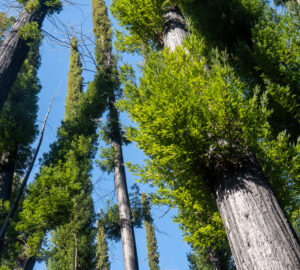
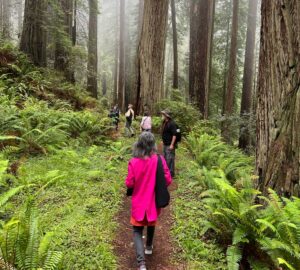
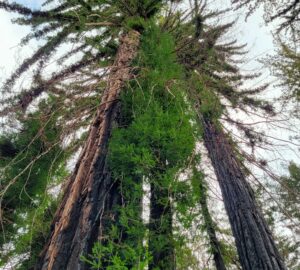
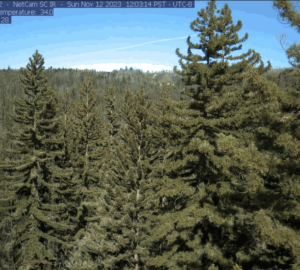
10 Responses to “Resilience of giant sequoia put to the test in the Sierra”
Deborah Hals
Thanks for inspirational, and hopeful news regarding the magnificent sequoia forests and the fire status. In the midwest, we don’t often hear about latest developments with the fire situation in California. We appreciate the information, and say a prayer that nature triumphs!
Patricia Bleha
Thank you keeping us informed. We have to get the message to our state legislature to pass a big meaningful appropriations bill to fund better maintenance of our precious redwoods and sequoias and other old growth forests. They adjourned without passing legislation in late Aug. The governor could call them back. What about the animals? No one mentions them! Let’s get the federal government on board, too for scientific management of our forests.
Carl Baker
Thanks much for keeping us informed Sam with your well written articles. Lets hope the great power and resilience of these magnificent trees allows them to come through this catastrophe. Best to all there and great thanks for your efforts to save the redwoods.
Gregory Schuett
This is yet another reminder of the urgency in which we should be reducing the fuel load in the redwood and sequoia groves. Thinning the other tree species and brush and using prescribed burning during the wet winters will be crucial in protecting these groves of magnificent trees in the future.
Alan L Lovett
Given the impact of global warming on our forests, has The League ever considered moving some resources to preserve and protect land already acquired? For example, emergency aid for fires moving into protected areas? Thank you
Bill Morgan
Who ya kidding. These Redwoods have survived fires of this magnitude for thousands of years. The man made structures may be destroyed, and the stupid people who build in fire zones may be gone but the Redwoods will be fine
Bill Morgan
Pottstown Pa
Bilhee@aol.com
Carole Menninger
So sick at heart to witness so much devastation in California and other parts of the west coast. Have been doing a whole lot of praying for all of you and that they will be able to get these under control soon, hopefully with some rain. Have never been to this part of our country but it has been a life long dream of mine to see these magnificent Redwoods one day. This is a hard lesson but one that I hope will be taken to heart by our government that we must address climate change. Stay safe.
Sally Grimmer
My heart breaks for your residents and the giant sequoia. My hope is that the sequoia’s resiliency will prove itself in this horrific situation. God’s blessings to you and your residents and all of the firefighting heroes out there battling this tragic event.
Grace Hoagland
This is helpful, reassuring, and extraordinarily well-written. Here’s to resilience and hope, with immense thanks to the firefighters and deep concern for so many who have lost so much.
Thanks!
John Burridge
How depressing for all of California and the west, but the fire-resistance of redwoods at least give some hope to those species if not their neighboring trees. Hopefully the giants will suffer minimal harm. (I live in the east now, but many years ago I lived in Boulder Creek with a marvelous Santa Cruz redwood taking up the whole front yard.)